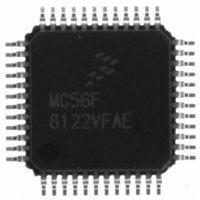MC56F8122VFAE Freescale Semiconductor, MC56F8122VFAE Datasheet - Page 131

MC56F8122VFAE
Manufacturer Part Number
MC56F8122VFAE
Description
IC DSP 16BIT 40MHZ 48-LQFP
Manufacturer
Freescale Semiconductor
Series
56F8xxxr
Datasheet
1.MC56F8122VFAE.pdf
(136 pages)
Specifications of MC56F8122VFAE
Core Processor
56800
Core Size
16-Bit
Speed
40MHz
Connectivity
SCI, SPI
Peripherals
POR, WDT
Number Of I /o
21
Program Memory Size
32KB (16K x 16)
Program Memory Type
FLASH
Ram Size
4K x 16
Voltage - Supply (vcc/vdd)
2.25 V ~ 3.6 V
Data Converters
A/D 6x12b
Oscillator Type
Internal
Operating Temperature
-40°C ~ 105°C
Package / Case
48-LQFP
Data Bus Width
16 bit
Processor Series
MC56F81xx
Core
56800E
Maximum Clock Frequency
40 MHz
Number Of Programmable I/os
21
Data Ram Size
8 KB
Operating Supply Voltage
- 0.3 V to + 4 V
Maximum Operating Temperature
+ 105 C
Mounting Style
SMD/SMT
Data Rom Size
8 KB
Minimum Operating Temperature
- 40 C
Lead Free Status / RoHS Status
Lead free / RoHS Compliant
Eeprom Size
-
Lead Free Status / Rohs Status
Lead free / RoHS Compliant
Available stocks
Company
Part Number
Manufacturer
Quantity
Price
Company:
Part Number:
MC56F8122VFAE
Manufacturer:
Freescale Semiconductor
Quantity:
10 000
Part 12 Design Considerations
12.1 Thermal Design Considerations
An estimation of the chip junction temperature, T
T
where:
The junction to ambient thermal resistance is an industry-standard value that provides a quick and easy
estimation of thermal performance. Unfortunately, there are two values in common usage: the value
determined on a single-layer board and the value obtained on a board with two planes. For packages such
as the PBGA, these values can be different by a factor of two. Which value is closer to the application
depends on the power dissipated by other components on the board. The value obtained on a single layer
board is appropriate for the tightly packed printed circuit board. The value obtained on the board with the
internal planes is usually appropriate if the board has low-power dissipation and the components are well
separated.
When a heat sink is used, the thermal resistance is expressed as the sum of a junction-to-case thermal
resistance and a case-to-ambient thermal resistance:
R
where:
R
change the case-to-ambient thermal resistance, R
sink, the air flow around the device, the interface material, the mounting arrangement on printed circuit
board, or change the thermal dissipation on the printed circuit board surrounding the device.
To determine the junction temperature of the device in the application when heat sinks are not used, the
Thermal Characterization Parameter (Ψ
measurement of the temperature at the top center of the package case using the following equation:
T
where:
Freescale Semiconductor
Preliminary
T
R
P
R
R
R
T
Ψ
P
J
J
D
θJA
θJC
D
A
T
θJΑ
θJA
θJC
θCA
JT
= T
= T
is device related and cannot be influenced by the user. The user controls the thermal environment to
= R
A
T
= Ambient temperature for the package (
= Junction to ambient thermal resistance (
= Power dissipation in the package (W)
=
=
=
= Thermocouple temperature on top of package (
= Thermal characterization parameter (
= Power dissipation in package (W)
+ (Ψ
+ (R
θJC
Package junction to ambient thermal resistance °C/W
Package junction to case thermal resistance °C/W
Package case to ambient thermal resistance °C/W
+ R
θJΑ
JT
x P
θCA
x P
D
D
)
)
56F8322 Technical Data, Rev. 16
JT
) can be used to determine the junction temperature with a
θCA
o
o
J
C)/W
, can be obtained from the equation:
C)
o
C/W)
. For instance, the user can change the size of the heat
o
C)
Thermal Design Considerations
131







